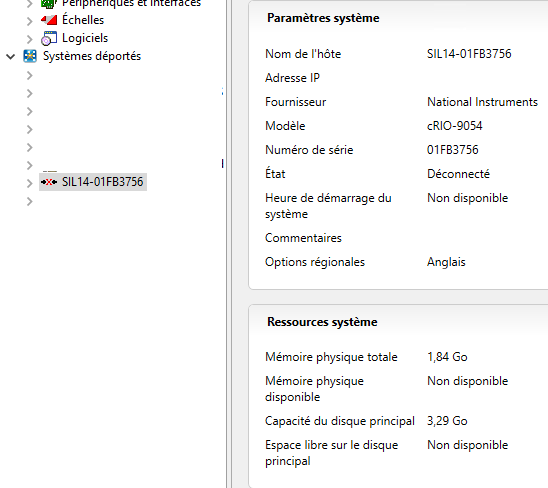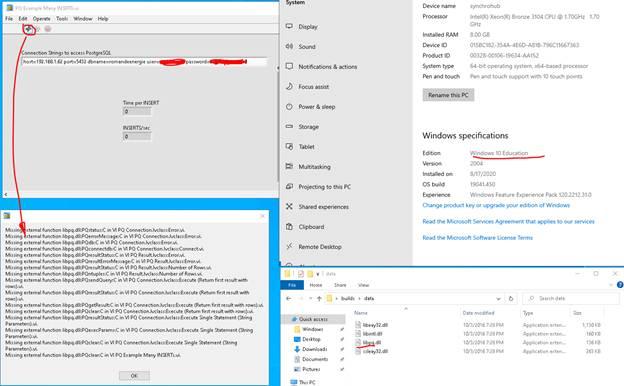
MzazM
Members-
Posts
13 -
Joined
-
Last visited
LabVIEW Information
-
Version
LabVIEW 2019
-
Since
2006
Recent Profile Visitors
The recent visitors block is disabled and is not being shown to other users.
MzazM's Achievements
-
LabVIEW, VIPM packages and tracking of their vulnerabilities.
MzazM replied to MzazM's topic in LabVIEW General
Hi @ShaunR, thanks for your answer. Indeed, knowing that, as of now, JKI does not provide authenticity verification of the packages we install is something worrying. It would not be easy to defend (read: get approval for) the cybersecurity and integrity of software built and deployed using such libraries. This is indeed a problem and I think it should be a feature request to VIPM forums. Link here if you or others are interested. Going back to my original question. What I meant is that normally cybersecurity vulnerabilities are published in such CVE lists (for example the one for LabVIEW) , so that users can get notified and decide to patch the application or not. In my understanding there is no way to understand if the packages we install are affected by a security vulnerability leading to a vulnerability in the application that is using them. For example, this happened with the famous Log4j vulnerability few months back, where millions applications and devices where suddenly exposed. Is such a list something that in the world of Package management in LabVIEW is available? -
Hello, cybersecurity requirements are asking to monitor vulnerabilities found in the libraries we use. While I found a CVE list for LabVIEW, I haven't found any CVE associated to the packages we install via VIPM? Do you think this should be something handled by JKI or by those that make their packages available via VIPM?
-
Hello, We have a cRio behind a router with SIM card. Router is configured to forward the following ports to cRio according to the articles here (link 1 and link2). - TCP 52725 / 3580 / 80 / 44516 - UDP 44515 / 44525 / 5353 The web UI works well with this setup, as well as a web service that is running on the cRio, same for SSH. NI MAX does not work. NI MAX finds the device at first, but after few seconds it transitions from the "connecting" state to a red-X icon (see screenshot). Before that it discovers the serial number and a few other parameters (not all). Has anyone accomplished something similar? Actually while searching for this, I found a message in the NI forum from a user with the same issue (from 2015) and another one from 2010. Nothing afterwards. Any idea? Thanks!
-
For allowing connection to LV, I had to open LV with sudo and from there configure the vi server port & authorization. I navigated to the LV installation folder and open it via cli with sudo ./labview or something similar. This, in my opinion, is because vipm is called by root and it uses root to call labview (it's my assumption!). Indeed, if I recall it right, all the packages that are then installed, have user and group set to root.
-
Hi, this is my guide on how I install VIPM on Linux. In this case Ubuntu (conversion of rpm to deb is done via alien). Hope it helps. VI Package Manager is not yet available for LabVIEW 2020 Linux follow up here. This is a workaround that can be used to install VIPM 2017 and make it work with LV2020 on Ubuntu Server. Useful links, especially about softlinks and icons are taken from here and here Assuming that the vipm tar file is placed in a VIPM folder in home, extract them in the home tar -pxvf ~/VIPM/vipm-17.0.2018-linux.tar Add i386 architecture (for downloading packages i386 that are needed) sudo dpkg --add-architecture i386 sudo apt-get update sudo apt-get install -y libxinerama1:i386 sudo apt-get install -y libgl1-mesa-glx:i386 sudo apt-get install -y xfonts-75dpi xfonts-100dpi Install dependencies: sudo apt-get install -y lib32stdc++6 sudo apt-get install -y lib32z1 Convert i386 into tgz and then back to deb (for alien to manage to convert 32bit packages in a 64bit system). Clean up and install LabVIEW 2015 cd ~/vipm-17.0.2018-linux/LabVIEW2015SP1RTE_Linux/ #sudo rm ni*.rpm sudo alien -ckt *i386.rpm sudo alien -ck *.tgz sudo rm *.tgz sudo rm *i386.rpm sudo alien -ck *.rpm sudo rm *.rpm sudo dpkg -i labview-2015-rte-32bit_15.0.1-1_all.deb Copy JKI folder, give proper permission and make links so that all libraries are found sudo cp -r ~/vipm-17.0.2018-linux/JKI /usr/local/ sudo chmod +x /usr/local/lib/LabVIEW-2015/liblvrt* sudo ln -sf "/usr/local/lib/LabVIEW-2015/" "/usr/lib/" sudo ln -sf "/usr/lib/LabVIEW-2015/liblvrtdark.so.15.0.1" "/usr/local/lib/liblvrtdark.so.15.0" sudo ln -sf "/usr/lib/LabVIEW-2015/liblvrt.so.15.0.1" "/usr/local/lib/liblvrt.so.15.0" Add VIPM in application launcher and make it start with sudo when clicking on it. I am attaching the vipm.policy, vipm.desktop and pkexec-vipm used below to this post. sudo cp -p "/usr/local/JKI/VIPM/icons/linux/VIPM 48x48 - 32bit.png" "/usr/share/pixmaps/VIPM_48x48_32bit.png" sudo cp ~/VIPM/vipm.policy /usr/share/polkit-1/actions/ sudo cp ~/VIPM/vipm.desktop /usr/share/applications/ sudo cp ~/VIPM/pkexec-vipm /usr/bin/ sudo chown root:root /usr/share/applications/vipm.desktop sudo chmod 644 /usr/share/applications/vipm.desktop sudo chown root:root /usr/share/polkit-1/actions/vipm.policy sudo chmod 644 /usr/share/polkit-1/actions/vipm.policy sudo chown root:root /usr/bin/pkexec-vipm sudo chmod 755 /usr/bin/pkexec-vipm pkexec-vipm vipm.desktop vipm.policy
-
Hello, I managed to install LV2020, and VIPM 2017 on Ubuntu 20.04. I am experiencing issues with the fonts in VIPM (some of the fonts are chinese and they are very ugly). LV2020 works well. I assume it is related to LV2015RTE. Do you see the same in your Debian installation?
-
Front Panels turning to gibberish Chinese (CAR 185890)
MzazM replied to eberaud's topic in LabVIEW General
Same issue for me. VIPM2017 and LV2020 on Ubuntu 20.04. no tmp files and .rsc file exists. Jibberish chinese and ugly fonts. I havent found workaround yet. -
here a post on how to update to the last sql libraries (3.34) to run successfully that example on NI RT
-
Yes, I agree with you. Indeed installing LabVIEW was the last thing I tried after almost 1week of more reasonable attempts (moving dlls, getting dll elsewhere and so on). When I removed LV the exe was complaining about missing external function. Installed runtime engine 2015 and it worked. I do not know why. I could check tomorrow on another system where I have the same exe running for a long time, if I also have the runtime 2015 installed.
-
We finally understood. We saw that a full LV2019SP1 f3 installation solved the problem. I then noted that Run-time Engine 2015 SP1f13 comes with it. I remembered that drjdpowell mentioned here that he is using LV 2015. So I removed the whole LV (double-checked that exe couldn't find dlls anymore), installed only the Run-time Engine 2015 SP1f13 and it worked immediately. Don't know why but it is not automatically installed with the installer.
-
Thanks for your answer. 1. The exe is at the correct path 2. I downloaded the latest dll that i found on your repo in bitbucket: https://bitbucket.org/drjdpowell/pq-labview/src/master/Connection/ . No difference. Important to notice that the same folder containing the exe (in the following screenshot I renamed the folder buildWin10Pro) works immediately in another Win10Education. The difference is that in this second system there is the whole LabVIEW, VI package manager and the Postgresql 0.1.1.9 package installed. Any follow up on this? Thanks!
-
Hello, we are experiencing a similar issue. We are using PostgreSQL 0.1.1.9. On dev computers, with Windows 10 Pro, I create an exe with the example PQ Example Many INSERTS provided by drjdpowell. We only modify ipaddress, username and password. Everything works fine. If I move the build folder (with the data folder) in a Win 10 Education, the exe cannot find the dlls. The attached image explains it all. Basically we get "Missing External function libpq.dll" even if the dll is in the data folder. This computer has NI run-time engine 2019 x86. Interestingly, if I put the same folder on another Windows 10 Education, where I have installed LV, VIPM and the PostgreSQL vip, the exe runs well. This computer has also NI run-time engine 2019 x86 (and others). Comparing the 2 Win 10 Education computers, It seems to me they both have the same Microsoft Visual C++ 2015-2019 Redistributable (x64) and Microsoft Visual C++ 2015 Redistributable (x86). I checked this aftert having read rolfk suggestion here What could the issue be? We are running out of things to attempt. Thanks for your support!
-
Thank you for this library. We are using it for a few weeks now. Mainly for inserts and some reads. We basically followed the example available in the installation folder. No RT at the moment.




